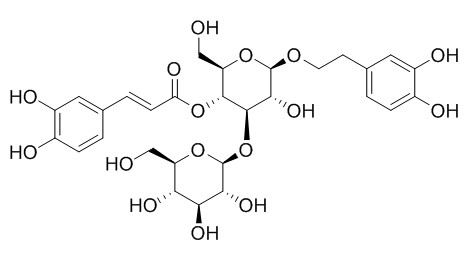Natural Products
Plantamajoside
| Catalog No. | CFN99522 |  |
| CAS No. | 104777-68-6 | |
| Molecular Weight: | 640.6 | |
| Molecular Formula | C29H36O16 | |
| DBs | [PubChem]:274950631 [ChEMBL]:8256 [PCIDB]:2767 |
Standard InChI:
InChI=1S/C29H36O16/c30-11-19-22(37)23(38)24(39)29(42-19)45-27-25(40)28(41-8-7-14-2-5-16(33)18(35)10-14)43-20(12-31)26(27)44-21(36)6-3-13-1-4-15(32)17(34)9-13/h1-6,9-10,19-20,22-35,37-40H,7-8,11-12H2/b6-3+/t19?,20?,22-,23+,24?,25?,26-,27-,28-,29+/m1/s1
Biological Activity
Plantamajoside has antibacterial activity, and has inhibition activity against cAMP phosphodiesterase and 5-lipoxygenase and antioxidant activity.[1]
Plantamajoside is a bioactive caffeic acid derivative, a dihydroxyphenethyl glucoside in the group of polyphenolic compounds, it is a protective agent against ultra-violet light in plants and acts as antioxidant agent with very low toxicity. [2]
Plantamajoside ameliorates lipopolysaccharide-induced acute lung injury via suppressing NF-κB and MAPK activation, thus, it may be a potential therapy for the treatment of pulmonary inflammation.[3]
Plantamajoside can inhibit UVB and advanced glycation end products‐induced MMP‐1 Expression by suppressing the MAPK and NF‐ĸB pathways in HaCaT cells, and attenuate the upregulation of receptor for AGEs (RAGE) by glycer-AGEs with UVB irradiation, suggests that it is a promising inhibitor of skin photoaging.[4]
Plantamajoside is a potential anti-tumor herbal medicine inhibits breast cancer growth and pulmonary metastasis by decreasing the activity of matrix metalloproteinase-9 and -2. [5]
Product
References
[1] Byung-Gyu Park †, Hyun-Sun Lee †, Jung S H, et al. Phytother Res, 2007, 21(12):1118-23.
[2] Ravn H W, Mondolot L, Kelly M T, et al. Phytochem Lett, 2015, 12:42-53.
[3] Wu H, Zhao G, Jiang K, et al. Int Immunopharmacol, 2016, 35:315-22.
[4] Han, Ah‐Ram, Nam, Mi‐Hyun, Lee, et al. Photochem Photobiol, 2016,6.
[5] Pei S, Yang X, Wang H, et al. Bmc Cancer, 2015, 15(1):1-12.
[6] Sun Q, Geng F, Cheng X, et al. China Journal of Chinese Materia Medica, 2010, 35(16):2095-8.
Product Use Citation





